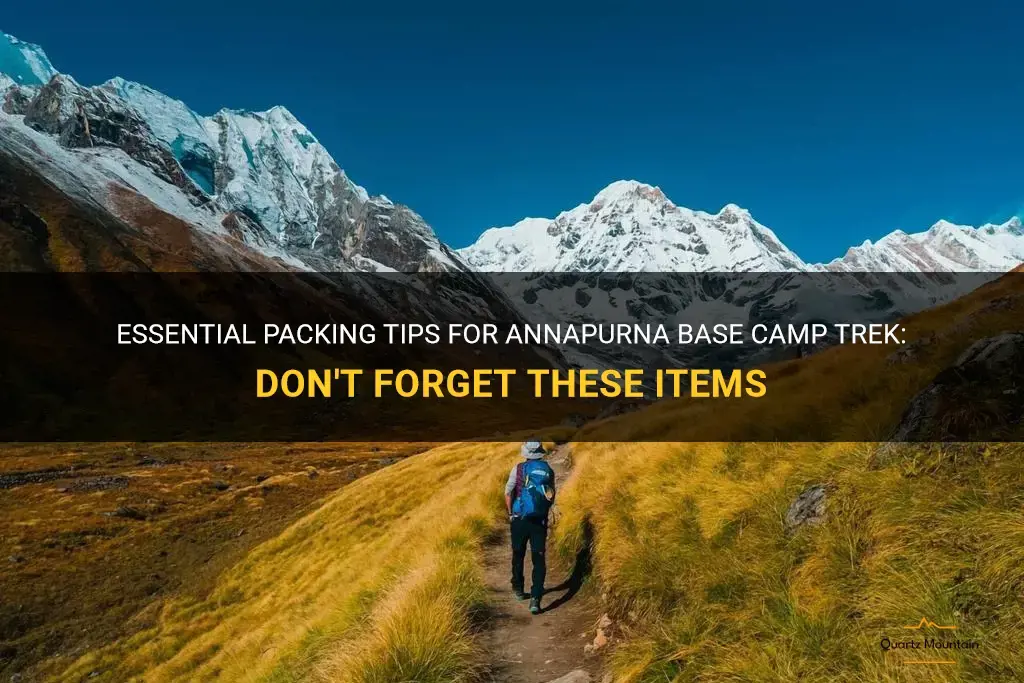
Are you planning on embarking on the adventurous Annapurna Base Camp Trek in Nepal? As you prepare for this incredible journey, it's important to pack wisely and efficiently. To ensure you have a smooth and enjoyable trek, we have compiled a list of essential items you must not forget. From appropriate clothing to navigation tools, this guide will help you navigate through the challenging terrain and unpredictable weather conditions. So, grab your backpack and let's dive into the must-haves for your Annapurna Base Camp Trek!
| Characteristics | Values |
|---|---|
| Altitude | 4,130 meters (13,550 feet) |
| Temperature | Varies from -15°C to 20°C |
| Clothing | Layered clothing, down jacket |
| Footwear | Hiking boots, warm socks |
| Backpack | 40-50 liter capacity |
| Sleeping bag | -15°C rating |
| Trekking poles | Adjustable and collapsible |
| Headlamp | With extra batteries |
| Water bottle | 2 liters capacity |
| Personal toiletries | Toothbrush, toothpaste, toilet paper |
| First aid kit | Band-aids, antiseptic ointment |
| Sun protection | Sunscreen, hat, sunglasses |
| Snacks | Energy bars, trail mix |
| Cash | Sufficient Nepali currency |
| Waterproof gear | Rain jacket, waterproof backpack |
| Maps or GPS | Annapurna Base Camp trail map |
| Electronics | Camera, extra batteries |
| Trekking permits | ACAP permit, TIMS card |
| Emergency contacts | Local emergency numbers |
What You'll Learn
- What are the essential items to pack for a trek to Annapurna Base Camp?
- How much warm clothing should I pack for Annapurna Base Camp?
- Are there any specific gear or equipment recommendations for the trek?
- Should I bring my own sleeping bag for Annapurna Base Camp?
- Are there any specific documents or permits I need to bring for the trek?

What are the essential items to pack for a trek to Annapurna Base Camp?
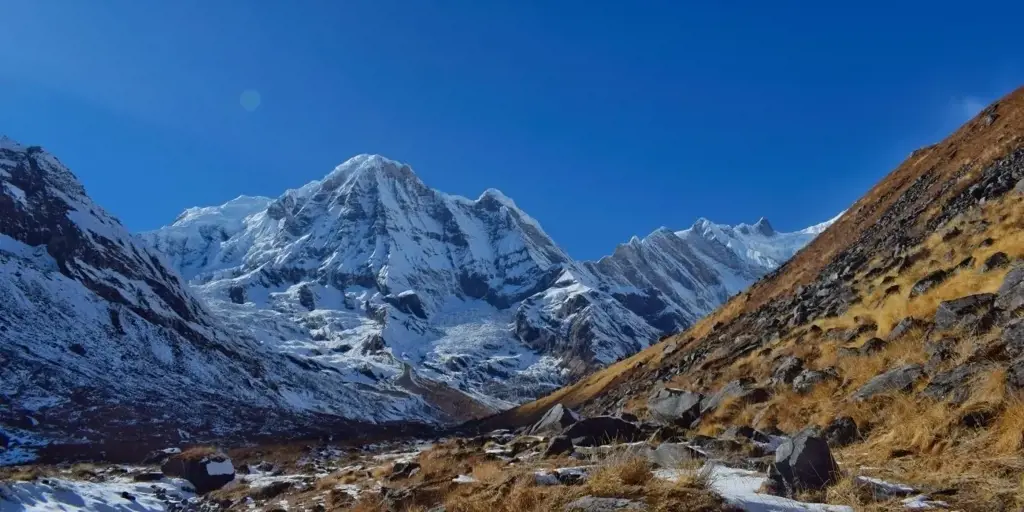
Trekking to Annapurna Base Camp is an exhilarating adventure that offers breathtaking views of the Himalayas and an opportunity to explore the natural beauty of the region. However, before embarking on this journey, it is important to pack all the essential items to ensure a safe and comfortable trek. Here is a list of some of the essential items that you should pack for a trek to Annapurna Base Camp:
- Hiking boots: A sturdy pair of hiking boots is crucial to protect your feet from the rugged terrains of the Annapurna region. Make sure your boots are comfortable, waterproof, and have good ankle support.
- Warm clothing: The weather in the Annapurna region can be unpredictable, so it is important to pack warm clothing. This includes thermal base layers, fleece jackets, down jackets, and a waterproof outer layer. Don't forget to pack a hat, gloves, and a scarf to protect your extremities from cold temperatures.
- Sleeping bag and sleeping pad: During the trek, you will be staying in teahouses and lodges, which provide basic accommodation. However, it is advisable to carry a sleeping bag and sleeping pad for added comfort and hygiene.
- Backpack: A good-quality backpack is essential to carry all your belongings during the trek. Make sure it is sturdy, waterproof, and has enough capacity to hold your essentials.
- Trekking poles: Trekking poles are extremely helpful in providing stability and support while traversing the steep and uneven terrains of the Annapurna region. They reduce the strain on your knees and can prevent accidents or injuries.
- Water bottle and purification tablets: Staying hydrated is crucial during a trek. Carry a reusable water bottle and use purification tablets to ensure the water you drink is safe and clean.
- First aid kit: It is important to carry a basic first aid kit that includes band-aids, antiseptic ointment, painkillers, and any medications you may require. Also, make sure to carry a personal medical kit if you have any specific medical conditions.
- Sunscreen and sunglasses: The sun's rays can be harsh at higher altitudes, so it is important to protect your skin and eyes. Carry a high SPF sunscreen and a good pair of sunglasses with UV protection.
- Headlamp or flashlight: Most teahouses or lodges in the Annapurna region may have limited electricity supply or power outages. Therefore, it is essential to carry a headlamp or flashlight to navigate in low-light conditions.
- Snacks: While teahouses and lodges provide meals, it is advisable to carry some energy bars, nuts, and dried fruits as snacks to keep your energy levels up during the trek.
- Trekking map and guidebook: Carry a trekking map and guidebook to help you navigate the trails and provide you with valuable information about the region.
- Cash and identification: Make sure to carry enough cash in Nepali currency and a valid identification document to pay for accommodation, food, and other necessities along the trek.
It is important to pack light and only carry the essentials to make your trek more enjoyable and manageable. Additionally, it is advisable to check the weather forecast and consult with experienced trekkers or local guides to ensure you have all the necessary items for a successful trek to Annapurna Base Camp.
Choosing the Perfect Pack: Finding the Right Size for Your Inca Trail Adventure
You may want to see also

How much warm clothing should I pack for Annapurna Base Camp?
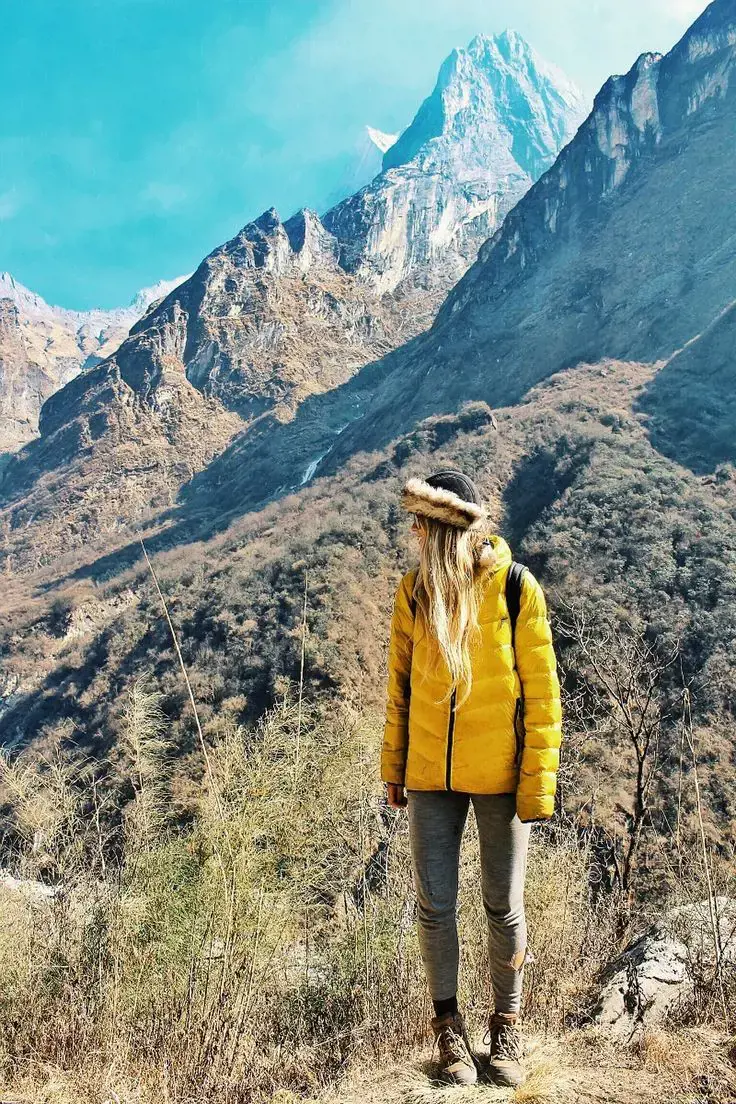
Annapurna Base Camp, located in Nepal's Himalayan region, is a popular trekking destination known for its breathtaking views and challenging terrain. As you embark on this adventure, one of the key considerations is packing appropriate clothing to keep yourself warm throughout the trek. In this article, we will discuss the essential warm clothing items you need to pack for Annapurna Base Camp.
Base Layers:
Base layers are the foundation of your clothing system. These should be made of moisture-wicking materials like merino wool or synthetic fabrics. Pack at least two sets of base layers, including long-sleeve tops and bottoms, to wear underneath your other clothing layers. These will help regulate your body temperature and keep you dry.
Insulating Layers:
Insulating layers are crucial for providing warmth in cold temperatures. Fleece jackets or down-filled jackets are excellent choices for Annapurna Base Camp. Consider packing at least one lightweight fleece jacket and a heavier down jacket to wear when temperatures drop significantly. Layering these jackets will provide extra insulation and help you stay warm.
Mid-Layers:
Mid-layers, such as a softshell jacket or a lightweight insulated jacket, are essential for additional warmth and protection against wind and moisture. These jackets can be worn over your base layers and underneath your outer shell jacket. They provide an extra layer of insulation and can be easily removed if the temperature rises or during intense physical activity.
Outer Shell Jacket:
An outer shell jacket is crucial for protecting yourself from wind, rain, and snow. Look for a waterproof and breathable jacket that will keep you dry in case of unexpected weather changes. Make sure the jacket has a hood and adjustable cuffs to seal out the elements effectively.
Bottoms:
Pack thermal or fleece-lined hiking pants as your bottom layer. These pants are designed to provide warmth and protection against cold temperatures. Additionally, pack a pair of waterproof and breathable pants to wear as an outer shell layer in case of rain or snow.
Accessory Items:
Don't forget to pack essential accessory items to keep your extremities warm. Woolen or fleece hats, gloves, and scarves are essential to protect your head, hands, and neck from cold temperatures. Pack at least one pair of warm socks and consider bringing gaiters to keep snow out of your boots.
It is essential to layer your clothing appropriately to regulate your body temperature effectively. Layering allows you to add or remove clothing as needed, depending on the weather conditions and your activity level. Remember to stay hydrated and take breaks to avoid overheating while trekking.
In conclusion, packing warm clothing for Annapurna Base Camp is crucial to ensure your comfort and safety during the trek. Layering base layers, insulating layers, mid-layers, and outer shell jackets will provide the necessary warmth and protection against cold temperatures, wind, and moisture. Don't forget to pack essential accessory items to keep your extremities warm. With the right clothing, you can fully enjoy the breathtaking beauty of Annapurna Base Camp while staying warm and comfortable.
What to Pack for a Sabi Sabi Safari Experience
You may want to see also

Are there any specific gear or equipment recommendations for the trek?
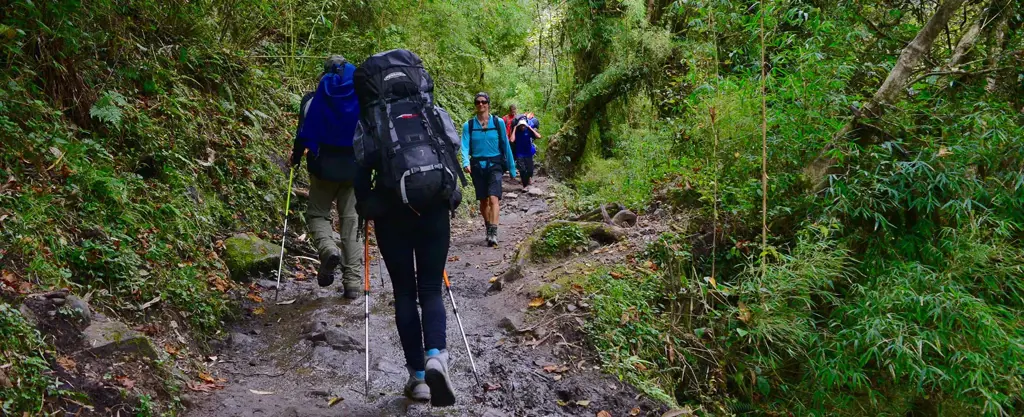
Trekking is a popular activity for adventure enthusiasts, and having the right gear and equipment can make a huge difference in the overall experience. When preparing for a trek, it is essential to pack suitable gear and equipment to ensure safety, comfort, and success.
Footwear:
One of the most critical pieces of gear for trekking is a sturdy and comfortable pair of trekking boots. Invest in a good quality pair that provides ankle support and has a durable sole for traction. Break them in before the trek to avoid blisters. Carry extra pairs of socks to keep your feet dry and prevent friction.
Clothing:
Layering is key when it comes to trekking. Pack lightweight, moisture-wicking, and quick-drying clothing for your trip. A base layer made of synthetic material or Merino wool will help regulate your body temperature and keep you dry. A mid-layer fleece or down jacket is essential for insulation in colder conditions. Finally, a waterproof and breathable outer layer, such as a rain jacket, will protect you from rain and wind.
Backpack:
Choose a backpack that is comfortable, lightweight, and has a capacity large enough to hold all your gear. Look for one with adjustable straps, a padded hip belt, and multiple pockets for organization. Make sure it fits your body properly and distribute weight evenly to avoid strain.
Sleeping bag and tent:
If you are planning on camping during your trek, a high-quality sleeping bag is a must. Make sure it is suitable for the expected temperatures and is lightweight for easy carrying. Additionally, consider the size and weight of your tent if you plan on staying overnight. Look for a tent that is easy to set up and provides adequate protection from the elements.
Navigation tools:
Carry a map, compass, and GPS when venturing into unfamiliar territory. Learn how to use these tools effectively and familiarize yourself with the route beforehand. It is essential to have a backup navigation system in case your electronics fail.
Hydration and food:
Staying hydrated and nourished is crucial during a trek. Carry a water bottle or hydration bladder to ensure you have a constant supply of water. Pack energy bars, nuts, and dehydrated meals for sustenance on the trail. Remember to pack more food and water than you anticipate needing, as unexpected delays or longer treks are not uncommon.
First aid kit:
A well-stocked first aid kit is essential for any trek. Include items like bandages, antiseptic ointment, blister pads, pain relievers, and any personal medications you may need. Also, carry a whistle and a small flashlight in case of emergencies.
Other essentials:
Don't forget to pack essentials like a headlamp, trekking poles, sunglasses, sunscreen, insect repellent, a multi-tool, and a lightweight towel. Consider the climate and terrain of your trek and pack accordingly.
Before embarking on your trek, make sure to research the specific gear and equipment requirements for the region you will be visiting. Weather conditions, altitude, and terrain can vary, so tailoring your gear to suit these factors is crucial. Additionally, always test your gear before the trek to ensure everything is functioning correctly and fits comfortably.
In conclusion, having the right gear and equipment is essential for a successful and enjoyable trek. Invest in high-quality gear, pack appropriately for the conditions, and always prioritize safety and comfort. With the right gear, you can fully immerse yourself in the beauty of nature and make unforgettable memories on your trekking adventure.
Essential Items to Pack for a Glamping Adventure
You may want to see also

Should I bring my own sleeping bag for Annapurna Base Camp?
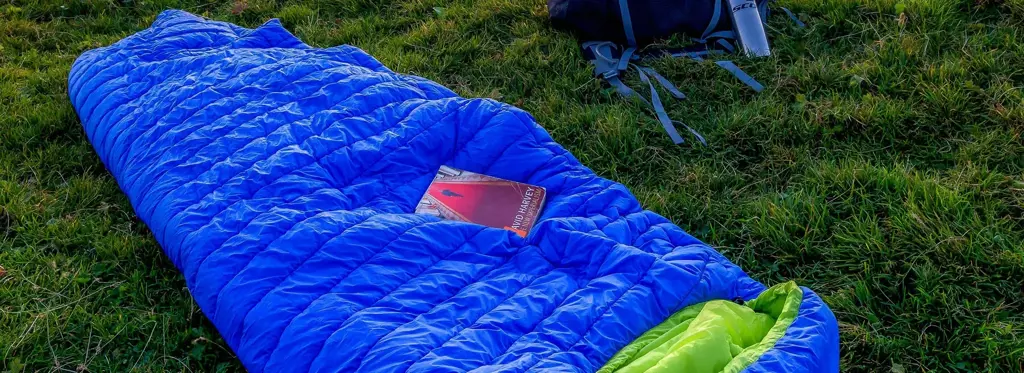
Annapurna Base Camp (ABC) is one of the most popular trekking destinations in Nepal and is known for its breathtaking scenery and challenging terrain. If you are planning a trip to ABC, one of the important decisions you will need to make is whether to bring your own sleeping bag or rent one.
Sleeping bags are an essential item for any trek, as they provide warmth and comfort during the cold nights at high altitudes. However, there are a few factors to consider when deciding whether to bring your own sleeping bag for Annapurna Base Camp.
- Temperature: The temperature at Annapurna Base Camp can drop below freezing at night, especially during the winter months. It is crucial to have a sleeping bag that is suitable for these low temperatures. While you can rent a sleeping bag in Nepal, it may not be warm enough to keep you comfortable during the night. Bringing your own sleeping bag will ensure that you have the right level of insulation to stay warm and get a good night's sleep.
- Hygiene: Renting a sleeping bag means using a bag that has been used by numerous trekkers before you. While rental companies may wash the sleeping bags regularly, there is still a risk of coming into contact with germs or bed bugs. If you have concerns about hygiene, bringing your own sleeping bag will eliminate these worries and provide you with a clean and comfortable sleeping environment.
- Comfort: Everyone has different preferences when it comes to sleeping arrangements. Some people may find rental sleeping bags uncomfortable or too small. By bringing your own sleeping bag, you can choose a bag that suits your sleeping style and preferences, ensuring a more restful night's sleep.
- Cost: Renting a sleeping bag in Nepal is relatively inexpensive, especially compared to purchasing a high-quality sleeping bag. However, if you plan on doing multiple treks in the future or if you value the benefits of having your own sleeping bag, investing in a good quality bag may be a wise choice in the long run. Additionally, renting a sleeping bag for an extended period can add up, and the cost may eventually be similar to purchasing your own.
In conclusion, bringing your own sleeping bag for Annapurna Base Camp has several advantages. It ensures that you have a sleeping bag suitable for the low temperatures, eliminates concerns about hygiene, allows you to choose a bag that is comfortable for you, and may even save you money in the long run. However, if you are only planning a one-time trek and want to travel light, renting a sleeping bag is a convenient option. Ultimately, the decision depends on your personal preferences, budget, and trekking plans.
Essential Items to Pack for a Memorable Summer Trip to Lake Tahoe
You may want to see also

Are there any specific documents or permits I need to bring for the trek?
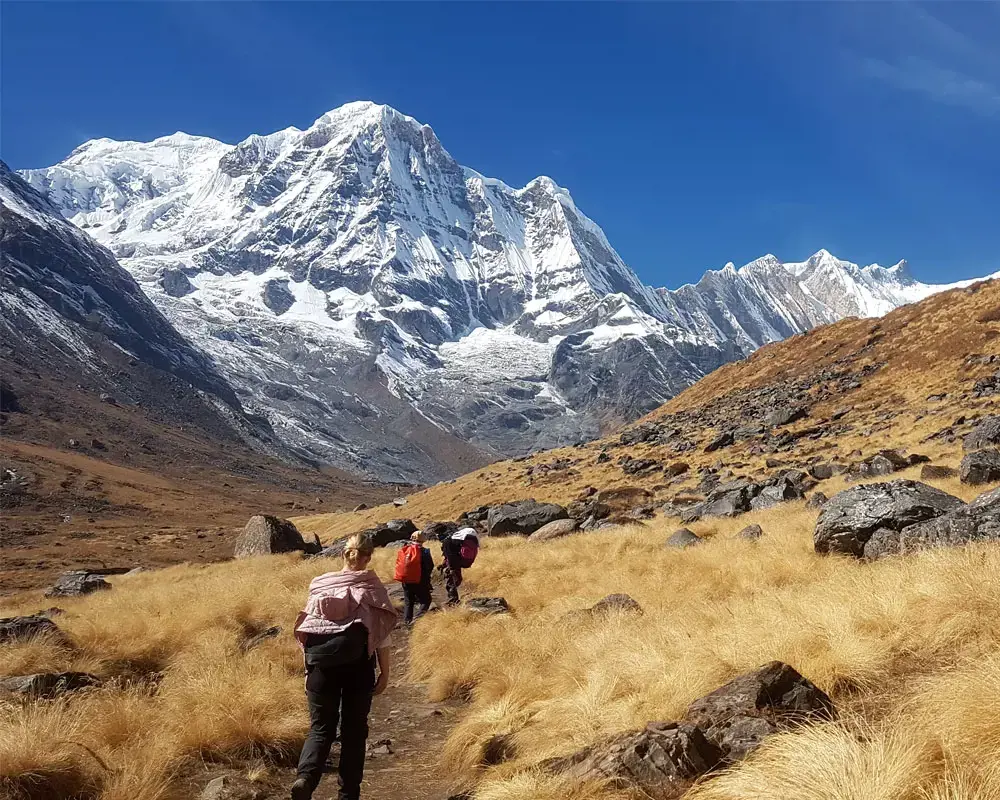
When planning for a trek, it is essential to ensure that you have all the necessary documents and permits in place. These documents not only provide essential information but also ensure that you comply with any local regulations and restrictions. Here are some documents and permits that you may need to bring for your trek:
- Identification documents: Regardless of where you are trekking, it is crucial to carry your identification documents, such as your passport or driver's license. These documents not only serve as proof of identity but may also be required for permits and access to certain areas.
- Trekking permits: Many trekking destinations around the world require visitors to obtain trekking permits. These permits help in regulating the number of visitors and ensure the preservation of the environment and local culture. The type of permit required may vary depending on the trekking destination. For example, if you are planning to trek in the Everest region of Nepal, you will need a Sagarmatha National Park Permit and a TIMS (Trekkers' Information Management System) card. These permits can usually be obtained from the respective national park or tourism offices.
- Medical documents: If you have any pre-existing medical conditions or allergies, it is essential to carry your medical documents, including prescriptions and medical history. In case of any medical emergencies during the trek, these documents can help medical professionals provide appropriate treatment.
- Travel insurance: Trekking involves potential risks, including injuries and illnesses. Therefore, it is highly recommended to have travel insurance that covers trekking activities. Your insurance should provide adequate medical coverage, emergency evacuation, and trip cancellation or interruption. Make sure to read the policy carefully to understand what is covered and what is not.
- Local permits or passes: In some trekking destinations, there may be additional permits or passes required to access certain areas or trails. For example, if you are trekking in the Annapurna region of Nepal, you will need an Annapurna Conservation Area Permit (ACAP) and a TIMS card. These permits are usually available at the entrance points of the respective conservation areas.
- Itinerary and contact information: It is advisable to carry a copy of your trekking itinerary, including details of your accommodation and contact information of your trekking agency or guide. This information can be useful in case of an emergency or if you need assistance during your trek.
Before embarking on your trek, it is crucial to research and understand the specific documentation and permits required for your chosen destination. Keep in mind that the requirements may vary based on the country, region, and duration of your trek. It is recommended to consult with a local trekking agency or check the official government websites for up-to-date information on the required documents and permits.
To summarize, for a trek, you may need to bring identification documents, trekking permits, medical documents, travel insurance, local permits or passes, and a copy of your itinerary. Ensuring that you have all the necessary documents and permits will help you have a smooth and hassle-free trekking experience while complying with local regulations and restrictions.
The Ultimate Guide: What to Pack - Clip Art Edition
You may want to see also
Frequently asked questions
When packing for the Annapurna Base Camp trek, it is important to pack lightweight clothing that can be layered, as weather conditions can vary. Pack a good quality waterproof jacket, fleece or down jacket, thermal base layers, quick-dry hiking pants, and a hat and gloves for cold weather. Don't forget to bring a good pair of hiking boots, sunglasses, sunscreen, a daypack, a refillable water bottle, a headlamp, a first aid kit, and a camera to capture the stunning views.
It is recommended that you carry a pack that weighs no more than 10-15% of your body weight on the Annapurna Base Camp trek. This will ensure that you can comfortably carry your belongings without straining your back or legs. It is also important to pack efficiently and only bring essential items to keep your pack as light as possible.
Yes, it is highly recommended to bring trekking poles for the Annapurna Base Camp trek. Trekking poles can greatly reduce the strain on your knees and provide stability on uneven terrain. They also help to improve balance and reduce the risk of falls, especially when crossing rivers or steep sections of the trail. Make sure to pack adjustable trekking poles that can be easily adjusted to your height.
The best footwear for the Annapurna Base Camp trek is a sturdy pair of hiking boots that provide ankle support and have a good grip on varying terrain. It is important to invest in a pair of boots that are comfortable and well-fitted to avoid blisters and foot pain. Break in your boots before the trek to ensure they are comfortable and won't cause any discomfort or injuries during the hike.
Yes, it is necessary to bring a sleeping bag for the Annapurna Base Camp trek. The teahouses along the trek do provide blankets, but they may not be sufficient to keep you warm during the cold nights at higher altitudes. It is recommended to bring a sleeping bag rated for temperatures of -10 to -15 degrees Celsius to ensure a comfortable night's sleep. Additionally, make sure to pack a sleeping bag liner for added warmth and cleanliness.







